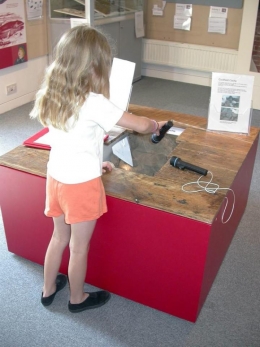Deliberately Concealed Garments Project
The Deliberately Concealed Garments Project (DCGP) was initiated at the Textile Conservation Centre in 1998 by Dinah Eastop, Senior Lecturer, in order to research the tradition of concealing garments within buildings.
The project was generously funded by the L.J. and Mary C. Skaggs Foundation (award made in 2001) and by the AHRB/AHRC (initially by an AHRB GRANT B/SG/AN6782/APN12795) and later as part of the AHRC Research Centre for Textile Conservation and Textile Studies (2002-2007).
The objectives of the research project were to:
- Raise awareness of finds and their significance via the identification and recording of finds; via publications, lectures, web-mailings, site visits, media interviews and a touring exhibition called ‘Hidden House History’. See pdf attached on this page with data about website visits, mailings, etc. The exhibition was arranged by the Textile Conservation Centre, in conjunction with the Hampshire County Council Museum and Archive Service (HCCMAS), to explore the practice of concealing garments and other objects. The exhibition, called Hidden House History, toured 6 venues in Hampshire and Dorset in 2005 and 2006. The exhibition featured once-concealed garments; some were displayed in custom-made cases replicating three cache sites: under floorboards, within a wall and by a fireplace. These displays were complemented by large wall-mounted display panels addressing key questions relating to finds and concealment practices, as well as series of ‘interactives’ designed for families.
- Create a database of finds: hundreds of garments finds have been identified and recorded.
- Publish results of the research in both national and international publications; see pdf attached on this page.
- Research concealment traditions in UK, via a literature survey, site visits and interviews with finders, which introduced an oral history component to the project because we became aware of the importance of recording finders’ responses to the finds they had uncovered; see pdf attached on this page for bibliography.
- Inform decisions about the conservation of finds, e.g. Barbieri 2002; Duffield 2004. Developments in DNA typing and X-radiography techniques to reveal more about the materials and construction of once-concealed garments were explored. For example, X-radiography of the Nether Wallop stomacher (Barbieri 2007) revealed the extent of the ‘whalebone’ (baleen) stiffening inside the stomacher. DNA analysis of a sample removed form the stomacher identified the baleen as coming from a North Atlantic Right Whale of a now extinct matrilineage of whales (Eastop and McEwing 2005).

